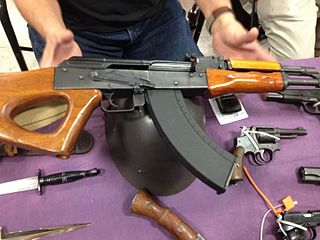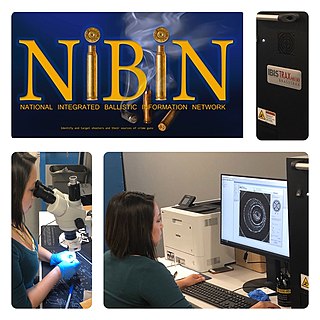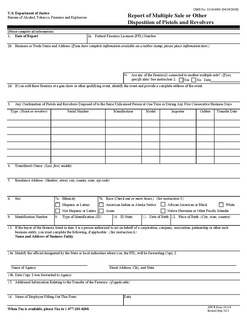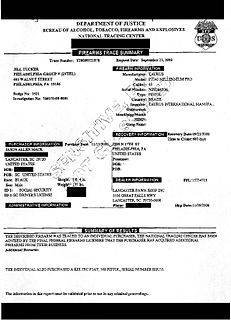Related Research Articles

The National Firearms Act (NFA), 73rd Congress, Sess. 2, ch. 757, 48 Stat. 1236 was enacted on June 26, 1934, and currently codified and amended as I.R.C. ch. 53. The law is an Act of Congress in the United States that, in general, imposes an excise tax on the manufacture and transfer of certain firearms and mandates the registration of those firearms. The NFA is also referred to as Title II of the federal firearms laws, with the Gun Control Act of 1968 ("GCA") as Title I.

The Bureau of Alcohol, Tobacco, Firearms, and Explosives (ATF), also referred to as BATFE, is a domestic law enforcement agency within the United States Department of Justice. Its responsibilities include the investigation and prevention of federal offenses involving the unlawful use, manufacture, and possession of firearms and explosives; acts of arson and bombings; and illegal trafficking and tax evasion of alcohol and tobacco products. The ATF also regulates via licensing the sale, possession, and transportation of firearms, ammunition, and explosives in interstate commerce. Many of the ATF's activities are carried out in conjunction with task forces made up of state and local law enforcement officers, such as Project Safe Neighborhoods. The ATF operates a unique fire research laboratory in Beltsville, Maryland, where full-scale mock-ups of criminal arson can be reconstructed. The agency is led by Marvin Richardson, Acting Director. Richardson previously served as the Associate Deputy Director and Chief Operating Officer, the second highest ranking official at ATF, from October 2019 to June 2021. The ATF has 5,101 employees and an annual budget of $1.274 billion (2019).

In the United States, a gun show is an event where promoters generally rent large public venues and then rent tables for display areas for dealers of guns and related items, and charge admission for buyers. The majority of guns for sale at gun shows are modern sporting firearms. Approximately 5,000 gun shows occur annually in the United States.

The Firearm Owners' Protection Act (FOPA) of 1986 is a United States federal law that revised many provisions of the Gun Control Act of 1968.
A Federal Firearms License (FFL) is a license in the United States that enables an individual or a company to engage in a business pertaining to the manufacture or importation of firearms and ammunition, or the interstate and intrastate sale of firearms. Holding an FFL to engage in certain such activities has been a legal requirement within the United States since the enactment of the Gun Control Act of 1968. The FFL is issued by the Bureau of Alcohol, Tobacco, Firearms, and Explosives

A Firearms Transaction Record, or ATF Form 4473, is a six-page form prescribed by the Bureau of Alcohol, Tobacco, Firearms and Explosives (ATF) required to be completed when a person proposes to purchase a firearm from a Federal Firearms License (FFL) holder, such as a gun dealer.

The National Instant Criminal Background Check System (NICS) is a background check system in the United States created by the Brady Handgun Violence Prevention Act of 1993 to prevent firearm sales to people prohibited under the Act. The system was launched by the Federal Bureau of Investigation (FBI) in 1998. Under the system, firearm dealers, manufacturers or importers who hold a Federal Firearms License (FFL) are required to undertake a NICS background check on prospective buyers before transferring a firearm. The NICS is not a gun registry, but is a list of persons prohibited from owning or possessing a firearm. The buyer’s details are discarded after the query and a record on NICS of the firearm purchase is not made, though the seller as a FFL holder is required to keep a record of the transaction.

Gun show loophole is a political term in the United States referring to the sale of firearms by private sellers, including those done at gun shows, that do not require the seller to conduct a federal background check of the buyer. This is also called the private sale exemption. Under federal law, any person may sell a firearm to a federally unlicensed resident of the state where they reside, as long as they do not know or have reasonable cause to believe that the person is prohibited from receiving or possessing firearms.
The Youth Crime Gun Interdiction Initiative (YCGII) was led by the Bureau of Alcohol, Tobacco, Firearms and Explosives (ATF) during the late-1990s. The program aimed to increase firearm tracing of firearms recovered by law enforcement agencies, learn more about how juveniles and youth obtain firearms, and develop strategies to deal with problems involving illegally obtained firearms.
In the United States, access to guns is controlled by law under a number of federal statutes. These laws regulate the manufacture, trade, possession, transfer, record keeping, transport, and destruction of firearms, ammunition, and firearms accessories. They are enforced by state agencies and the federal Bureau of Alcohol, Tobacco, Firearms and Explosives (ATF).

The National Integrated Ballistic Information Network or NIBIN is a specialized computer network in the United States. It contains digital images of recovered pieces of ballistic evidence.

Report of Multiple Sale or Other Disposition of Pistols and Revolvers, or ATF Form 3310.4, is a form prescribed by the Bureau of Alcohol, Tobacco, Firearms, and Explosives (ATF) for use by firearm dealers holding a Federal Firearms License (FFL) to report when an unlicensed person purchases or acquires two or more handguns at one time or during five consecutive business days.

Violent Crime Impact Teams (VCIT) in the United States work proactively to identify, disrupt, arrest and prosecute the most violent criminals through innovative technology, analytical investigative resources and an integrated federal, state and local law enforcement strategy along with the leading federal law enforcement agency for the VCIT, the Bureau of Alcohol, Tobacco, Firearms and Explosives (ATF).
Project Gunrunner is a project of the U.S. Bureau of Alcohol, Tobacco, Firearms and Explosives (ATF) intended to stem the flow of firearms into Mexico, in an attempt to deprive the Mexican drug cartels of weapons.

eTrace is an Internet-based firearm trace request submission system, developed by the United States' federal government, Bureau of Alcohol, Tobacco, Firearms and Explosives, that provides for the electronic exchange of traced firearm data in a secure internet-based environment. Participating law enforcement agencies with access to the internet can acquire 24/7 real-time capabilities to electronically submit firearm trace requests, monitor the progress of traces, retrieve completed trace results, and to query firearm trace related data in Bureau of Alcohol, Tobacco, Firearms and Explosives (ATF) firearms registration database at the National Tracing Center. Firearms tracing is the systematic tracking of the movement of a firearm from its creation by the manufacturer or its introduction into U.S. commerce by the importer, through the distribution chain to the first retail purchase. Release 4.0, a bilingual version of eTrace was deployed in December, 2009 for the benefit of Spanish-speaking countries.
The U.S. Bomb Data Center serves as a nationwide collection center for information regarding arson and explosives related events throughout the United States. The Center was established in 1996 as a result of a congressional mandate and utilizes information from various government organizations such as the Bureau of Alcohol, Tobacco, Firearms and Explosives; the Federal Bureau of Investigation; and the United States Fire Administration.
The Tiahrt Amendment is a provision of the U.S. Department of Justice 2003 appropriations bill that prohibits the National Tracing Center of the Bureau of Alcohol, Tobacco, Firearms and Explosives (ATF) from releasing information from its firearms trace database to anyone other than a law enforcement agency or prosecutor in connection with a criminal investigation. This precludes gun trace data from being used in academic research of gun use in crime. Additionally, the law blocks any data legally released from being admissible in civil lawsuits against gun sellers or manufacturers.
Mexicans have a right to own firearms, but legal purchase from the single Mexican gun shop in Mexico City, controlled by the Army, is extremely difficult. Guns smuggled into Mexico are sometimes obtained at gunshops in the United States and carried across the US-Mexico border. In other cases the guns are obtained through Guatemalan borders or stolen from the police or military. Consequently, black market firearms are widely available. Many firearms are acquired in the U.S. by women with no criminal history, who transfer their purchases to smugglers through relatives, boyfriends and acquaintances who then smuggle them to Mexico a few at a time. The most common smuggled firearms include AR-15 and AK-47 type rifles, and FN 5.7 caliber semi-automatic pistols. Many firearms are purchased in the United States in a semi-automatic configuration before being converted to fire as select fire machine guns. Mexico seized in 2009 a combined total of more than 4,400 firearms of the AK-47 and AR-15 type, and 30% of AK-47 type semi-automatic rifles seized have been modified as select fire weapons.

The Federal Firearms Act of 1938 (FFA) imposed a federal license requirement on gun manufacturers, importers, and persons in the business of selling firearms. The term federal firearms licensee (FFL) is used to refer to those on whom the license requirement is imposed. "FFL" is also used to refer to the license itself.
A privately made firearm is a firearm that lacks a commercially-applied serial number, rendering the weapon untraceable. The term is used mostly in the United States by gun control advocates, but it is increasingly being used by gun rights advocates and some in the firearm industry. Because home-manufacture of firearms for personal use is not considered to fall under the U.S. federal government's authority to regulate interstate commerce, individuals making their own firearms are not subject to federal or state commercial background check regulations. Persons otherwise prohibited from owning firearms under the Gun Control Act of 1968 are still legally barred from the manufacture, transfer, or possession of firearms or ammunition, regardless of the method of manufacture or acquisition.
References
- ↑ "National Tracing Center (NTC) | Bureau of Alcohol, Tobacco, Firearms and Explosives". Atf.gov. Archived from the original on 2015-06-11. Retrieved 2016-02-13.
- 1 2 "National Tracing Center | Bureau of Alcohol, Tobacco, Firearms and Explosives". Atf.gov. Retrieved 2016-02-13.
- 1 2 "eTrace: Internet-Based Firearms Tracing and Analysis". Bureau of Alcohol, Tobacco, Firearms and Explosives.
 This article incorporates text from this source, which is in the public domain .
This article incorporates text from this source, which is in the public domain . - ↑ "U.S. Efforts to Combat Firearms Trafficking to Mexico Have Improved, but Some Collaboration Challenges Remain" (PDF). Gao.gov. Retrieved 2 August 2019.
- 1 2 3 4 William J. Krouse (May 27, 2009). "Gun Control: Statutory Disclosure Limitations on ATF Firearms Trace Data and Multiple Hanggun Sales Reports" (PDF). Congressional Research Service.